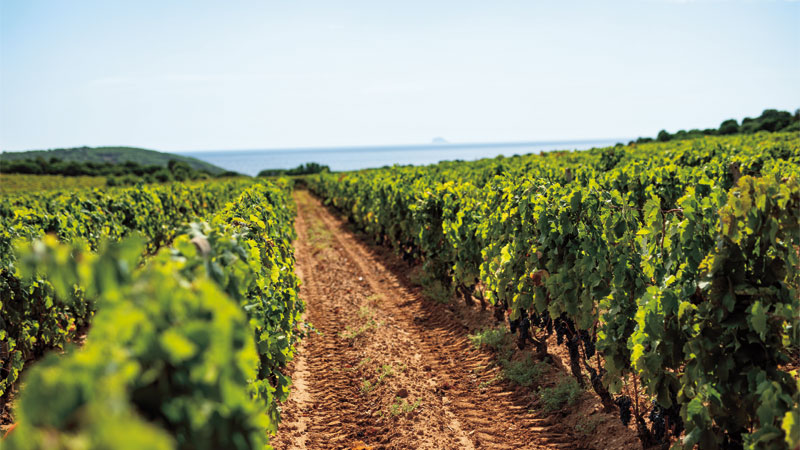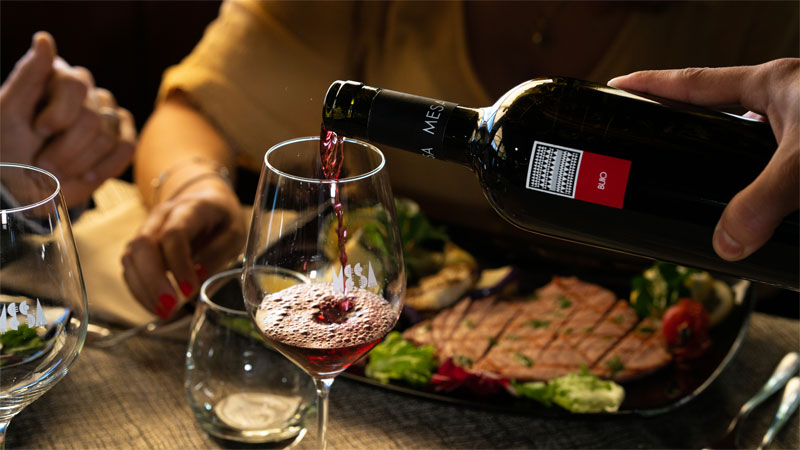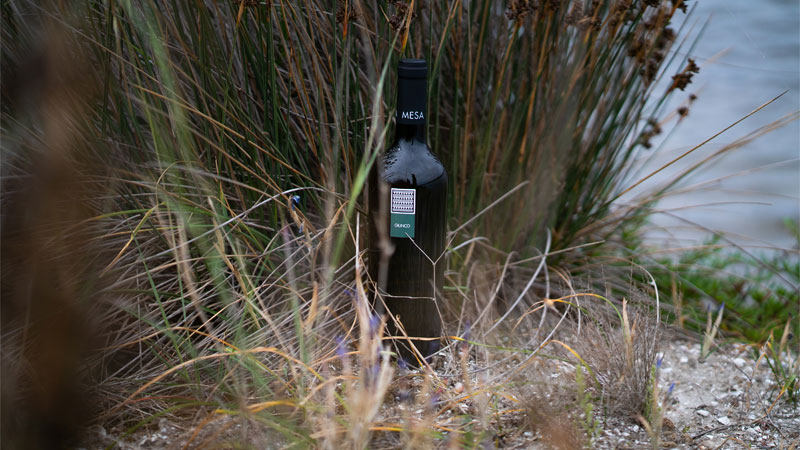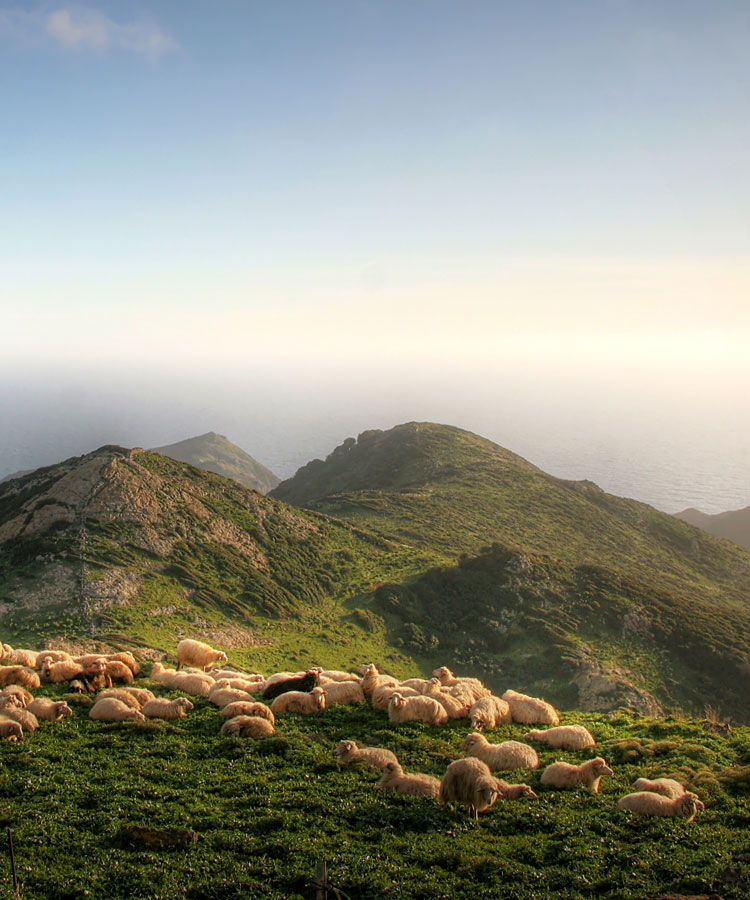
This article and the Visions of Italy series is sponsored by Santa Margherita USA.
A mere one-hour flight from Rome, across the blue-green Tyrrhenian Sea, plus a winding road trip through the hilly heart of Sardinia, will land you in front of the imposing facade of Cantina Mesa winery. The white, minimalist structure overlooks a lush marshland that borders the shimmering beaches of Porto Pino in the island’s southwestern Sulcis-Iglesiente region, a windswept place of striking beauty that hints at the vitality of the wines produced here.
Summer is unparalleled in this corner of the world. At the height of the season, vines are heavy with grapes — ruby-hued Carignano, light-skinned Vermentino, blood-red Cannonau, and more — and the undulating countryside around Cantina Mesa is enveloped in leafy green.
A beautiful seaside setting
The neighboring territories of Sulcis and Iglesiente make up Sardinia’s southernmost tip, which juts into the Mediterranean Sea. The soil here is a loamy sand riddled with limestone and red clay that’s rich in calcium and micronutrients, perfect for vineyards. Especially popular with tourists is the picturesque Sant’Anna Arresi area, home to a mile-long stretch of pine-lined beach — Porto Pino — whose white dunes soar to 100 feet.

Alongside vineyards, the hills are planted with olive, almond, and citrus trees and fields of artichokes, with sheep roaming the spaces in between. All manner of migratory birds — pink flamingos, diving cormorants, regal kingfishers, and graceful egrets —flock to these shores in summer, putting on quite the show. So, too, do the adrenaline-charged kitesurfers lured here by clear skies and crystalline waters.
A hot and dry climate
The local Mediterranean climate is generally agreeable with mild winters, but not without its challenges. Just 25.5 inches of rain fall here annually — in contrast, New York City gets about 45 inches each year — and temperatures in summer can rocket to 100 degrees Fahrenheit. However, savvy vintners versed in the latest winemaking techniques know how to coax the best yield from this land.
Choosing the right tract of land can make or break a vineyard. That’s why much of Cantina Mesa’s 78 hectares are located in a valley not far from Porto Pino, where they’re sheltered from the strong, northwesterly winds that roll in from southern France. Here, vines are trained vertically and treated to meticulous and constant pruning, ensuring they’ll produce grapes of the highest quality.
“Apparently, the combination of the island’s marine environment and coastal vineyards encourages more thorough ripening,” writes Ian D’Agata in his definitive work, “Native Wine Grapes of Italy.” The phenomenon is all the more magical because the scientific underpinning for it remains unclear. “I’m not sure anyone has ever furnished me with a physiologically plausible explanation,” D’Agata marvels.
Great grapes
The grape varieties that best thrive in this place are those best suited to mild, dry climates, grapes that are found in various corners of the Mediterranean. Among them is Carignano (a.k.a. Carignan), a deep red grape that originally hails from Spain and is believed to have been brought to Sardinia as early as the 9th century B.C. by seafaring Phoenicians.

In Cantina Mesa’s Buio (Italian for “darkness”) bottling, the grape’s deep color contributes to a dark, inky hue. Vintners at Cantina Mesa choose not to age the wine in oak in order to showcase the fruit in all its majesty: elegant aromas of ripe plum and red fruits with notes of black pepper. The full-bodied wine packs firm tannins and vibrant acidity with a lively finish. The expressive wine finds an ideal pairings in grilled red meats, seared tuna, and local pasta and rice dishes accented with Sardinian pecorino cheese.
Meanwhile, Buio-Buio — Italian for “very dark” — is aged for two years in barrique, yielding a nose of ripe red berry fruits and savory notes of balsamic and warm spices. The bottling boasts fine tannins, fresh acidity, and a long, multi-layered finish — the perfect match for roast game birds, wild boar, and matured cheeses.
Also remarkably successful in Sardinia is the white Vermentino grape, which produces a light-bodied but complex wine. Vermentino is planted all around the Mediterranean, from Provence to Liguria, but in this sun-drenched region, the grape is able to develop ripe tropical flavors alongside its usual minerality. In Cantina Mesa’s Primo Bianco, Vermentino yields a pale straw color with aromas of fresh citrus and apricot. Pair it with fish soups, grilled sea bass, and creamy cheeses like buffalo mozzarella and tangy goat cheese. Vermentino also shines in the winery’s fresh Giunco bottling, which is balanced with a stony minerality and ripe mango flavors. Drink it alongside platters of salt-baked fish and refreshing seafood crudos.

Another notable grape in Sardinia is Cannonau, a late-ripening Spanish grape better known elsewhere in world as Grenache. Spicy and berry-flavored, Cannonau benefits from the island’s dry heat and imparts supple tannins and a warm finish to Cantina Mesa’s ruby-hued Primo Scuro offering. The wine’s full-bodied aromas offer notes of wild red fruits and spice. It stands up well to fatty Italian cold cuts, strong-flavored fish, grilled meats, and soft cheeses.
No matter which bottle you choose, it will transport you to this sun-bleached, pine-scented island, bringing peak summer with it.
This article is sponsored by Cantina Mesa.



